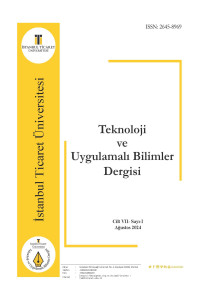Batılılaşma Dönemi Istanbul’da: Osmanlı Hanedan Türbeleri,Mimari Uslup ve Sedefli Sanduka Parmaklıkları
Abstract
Osmanlı Mimarisi, 18.yy Osmanlı İmparatorluğunun Batıya açılma dönemi olarak bilinir.‘‘Batılılaşma Dönemi
İstanbul’da: Osmanlı Hanedan Türbeleri, Mimari Uslup ve Sedefli Sanduka Parmaklıkları”,başlığı ile sunulan bu
makalede ;Osmanlı Hanedan Türbeleri,Mimari uslubu ; İstanbul Osmanlı Hanedan Türbelerinden 1818 yılında
inşa edilmiş Nakşidil Valide Sultan Türbesi üzerinden tartışmaya açılacaktır.
Nakşidil Valide Sultan, I.Abdülhamid’in hanımı ve II.Mahmud’un validesidir. İstanbul Suriçi, Fatih Külliyesi
Tabhanesi ve Fatih Cami Haziresi komşuluğunda konumlanan Nakşidil Valide Sultan Külliyesi, Batılılaşma
Dönemi etkisinde, Fatih Haziresinin güney doğu tarafında konumlanmıştır. Türbe barok mimari üslubundadır.
Geleneksel Türk El sanatlarından sedef kakma, oyma, ajur gibi birçok dalı içinde bulunduran Nakşidil Valide
Sultan Türbesi’ne ait sedefli sanduka parmaklıkları;kendi döneminin en seçkin örnekleri arasındadır.
Batılılaşma Dönemi ,Osmanlı Hanedan Türbelerinin,Mimari Uslubu ve Sedefli Sanduka Parmaklıklarının tasarımı
nasıldır? çalışmanın araştırma sorusunu oluşturmaktadır.
Bu çalışmada Batılılaşma Dönemi ,Osmanlı Hanedan Türbelerinin,Mimari Uslubu ve Sedefli Sanduka
Parmaklıklarının mevcut durumlarının tespitlerinin yapılması, fizibilite çalışmasıyla restorasyon uygulamasının
yapılması için başlangıç adımı olması amaçlanmaktadır.
Çalışmanın yöntemi, Batılılaşma Dönemi ,Osmanlı Hanedan Türbelerinin,Mimari Uslubu ve Sedefli Sanduka
Parmaklıklarının tasarımı Nakşidil Valide Sultan Türbesinde yerinde yapılan tespitler, konu ile ilgili literature
dayalı özgün bir çalışmadır.
Günümüzde taşınabilir ve taşınmaz kültür miraslarımıza sahip çıkmak, bakım ve onarımlarını yapmak, büyük
restorasyon çalışmalarının önüne geçmekle beraber, halihazırdaki durumun ileriki safhada ağır hasarsız olarak
değerlendirilebilmesi için önem arz etmektedir. Bu sanat eserlerinin gelecek kuşaklara aktarılması
gerekmektedir.Osmanlı Döneminde birçok hanedan türbesinde bulunan sedef kakma işçiliği mimari üslupla
birlikte farklı motifler kullanılarak sentezlenmiştir.
References
- Barışta, H. Örcün. (2005).Osmanlı İmparatorluğu Dönemi 19 ve 20. Yüzyıl Sedef İşlerine İstanbul Türbelerinden Sanduka Parmaklıkları Örnekler. Vakıflar Dergisi, 29: 463-480
- Halıcı,E.(2022).Nakşidil Valide Sultan Türbesi’nin Süsleme Programı ve Üslup Özellikleri,Sanat Tarihi Dergisi, 31/1,263-295.
- Hasol,Doğan.(2017).Ansiklopedik Mimarlık Sözlüğü.YEM Yayınları.
- Sözen,M.-Tanyeli, U.(2021).Sanat Kavram ve Terimleri Sözlüğü 21.baskı .Remzi Kitabevi Yayınları.
- Barışta, H. Örcün.(2009). Osmanlı İmparatorluğu Dönemi İstanbul Cami ve Türbelerinden Ağaç İşleri.AKM Yayınları
- Barışta, H. Örcün.(2015). Türk El Sanatları.AKM Yayınları
- Önkal,Hakkı.(2017). Osmanlı Hanedan Türbeleri, T.C Başbakanlık Atatürk, Dil ve Tarih Yüksek Kurumu Atatürk Kültür Merkezi Yayını.
- Kösekul,E.(2017). 19.ve 20.yy İstanbul Türbeleri. Atatürk Üniversitesi, Sosyal Bilimler Enstitüsü.Erzurum
- Ezen,Ü.Açelya.(2019).İstanbul’daki Batılılaşma Dönemi Osmanlı Hanedan Türbeleri,MSGSÜ,Sosyal Bilimler Enstitüsü,İstanbul
- Ağar,A.(2016).18.yy İstanbul Türbeleri.Çanakkale Onsekiz Mart Üniversitesi,Sosyal Bilimler Enstitüsü, Çanakkale
- Karakaya,E. (2006). Nakşidil Sultan Külliyesi.İslam Ansiklopedisi https://islamansiklopedisi.org.tr/naksidil-sultan-kulliyesi
- Akıncı,T.(2023). Nakşidil Valide Sultan Türbesi. https://www.turanakinci.com/portfolio-view/fatih-naksidil-valide-sultan-turbesi/
Westernization Period in Istanbul: Ottoman Dynasty Tombs, Architectural Style and Pearlescent Cistern Fences
Abstract
Ottoman Architecture The 18th century is known as the period of the Ottoman Empire's expansion to the West.
This text, presented with the title "Westernization Period in Istanbul: Dynastic Tombs, Architectural Style and
Mother-of-Pearl Sarcophagus Railings"; Ottoman Dynastic Tombs, Architectural Style; The Nakşidil Valide
Sultan Tomb, one of the Istanbul Ottoman Dynastic Tombs built in 1818, will be discussed. Nakşidil Valide
Sultan, wife of Abdulhamid I and Sultan Abdulhamid II. She is Mahmud's mother. Nakşidil Valide Sultan
Complex, located in the neighborhood of Istanbul Walled City, Fatih Social Complex Tabhane and Fatih
Mosque Graveyard, is located in the south-east position of Fatih Complex, under the influence of the
Westernization Period. The tomb is in the baroque architectural style. The mother-of-pearl sarcophagus railings
of the Nakşidil Valide Sultan Tomb, which includes many branches of traditional Turkish handicrafts such as
mother-of-pearl inlay, carving and openwork, are among the most distinguished examples of their period. What
is the Westernization Period, Ottoman Dynastic Tombs, Architectural Style and Design of Mother-of-Pearl
Sarcophagus Railings? It consists of the research results of the products. It is aimed to determine the current
conditions of this influential Westernization Period, Ottoman Dynastic Tombs, Architectural Style and Motherof-
Pearl Sarcophagus Railings, and to be the initial step to complete the restoration with the feasibility study.
The method of the study, the Westernization Period, the Architectural Style of the Ottoman Dynastic Tombs, the
design of the Mother of Pearl Sarcophagus Railings, the on-site findings in the Nakşidil Valide Sultan Tomb,
and the on-site findings are an original study based on the literature on the subject. Nowadays, it is important to
own our movable and immovable cultural heritages, to carry out their maintenance and repairs, and to achieve
major repairs, but the continuation of their permanence is important so that they can be evaluated undamaged at
a later stage. These works of art need to be transferred to future generations. The mother-of-pearl inlay
workmanship found in many dynasty tombs during the Ottoman Period was synthesized using different motifs
with the architectural style.
Keywords
Architectural Style Mother of Pearl Inlay Traditional Turkish Handicrafts Tomb Sarcophagus Railing
References
- Barışta, H. Örcün. (2005).Osmanlı İmparatorluğu Dönemi 19 ve 20. Yüzyıl Sedef İşlerine İstanbul Türbelerinden Sanduka Parmaklıkları Örnekler. Vakıflar Dergisi, 29: 463-480
- Halıcı,E.(2022).Nakşidil Valide Sultan Türbesi’nin Süsleme Programı ve Üslup Özellikleri,Sanat Tarihi Dergisi, 31/1,263-295.
- Hasol,Doğan.(2017).Ansiklopedik Mimarlık Sözlüğü.YEM Yayınları.
- Sözen,M.-Tanyeli, U.(2021).Sanat Kavram ve Terimleri Sözlüğü 21.baskı .Remzi Kitabevi Yayınları.
- Barışta, H. Örcün.(2009). Osmanlı İmparatorluğu Dönemi İstanbul Cami ve Türbelerinden Ağaç İşleri.AKM Yayınları
- Barışta, H. Örcün.(2015). Türk El Sanatları.AKM Yayınları
- Önkal,Hakkı.(2017). Osmanlı Hanedan Türbeleri, T.C Başbakanlık Atatürk, Dil ve Tarih Yüksek Kurumu Atatürk Kültür Merkezi Yayını.
- Kösekul,E.(2017). 19.ve 20.yy İstanbul Türbeleri. Atatürk Üniversitesi, Sosyal Bilimler Enstitüsü.Erzurum
- Ezen,Ü.Açelya.(2019).İstanbul’daki Batılılaşma Dönemi Osmanlı Hanedan Türbeleri,MSGSÜ,Sosyal Bilimler Enstitüsü,İstanbul
- Ağar,A.(2016).18.yy İstanbul Türbeleri.Çanakkale Onsekiz Mart Üniversitesi,Sosyal Bilimler Enstitüsü, Çanakkale
- Karakaya,E. (2006). Nakşidil Sultan Külliyesi.İslam Ansiklopedisi https://islamansiklopedisi.org.tr/naksidil-sultan-kulliyesi
- Akıncı,T.(2023). Nakşidil Valide Sultan Türbesi. https://www.turanakinci.com/portfolio-view/fatih-naksidil-valide-sultan-turbesi/
Details
| Primary Language | Turkish |
|---|---|
| Subjects | Architectural Heritage and Conservation |
| Journal Section | Research Articles |
| Authors | |
| Publication Date | August 29, 2024 |
| Submission Date | January 25, 2024 |
| Acceptance Date | April 13, 2024 |
| Published in Issue | Year 2024 Volume: 7 Issue: 1 |


